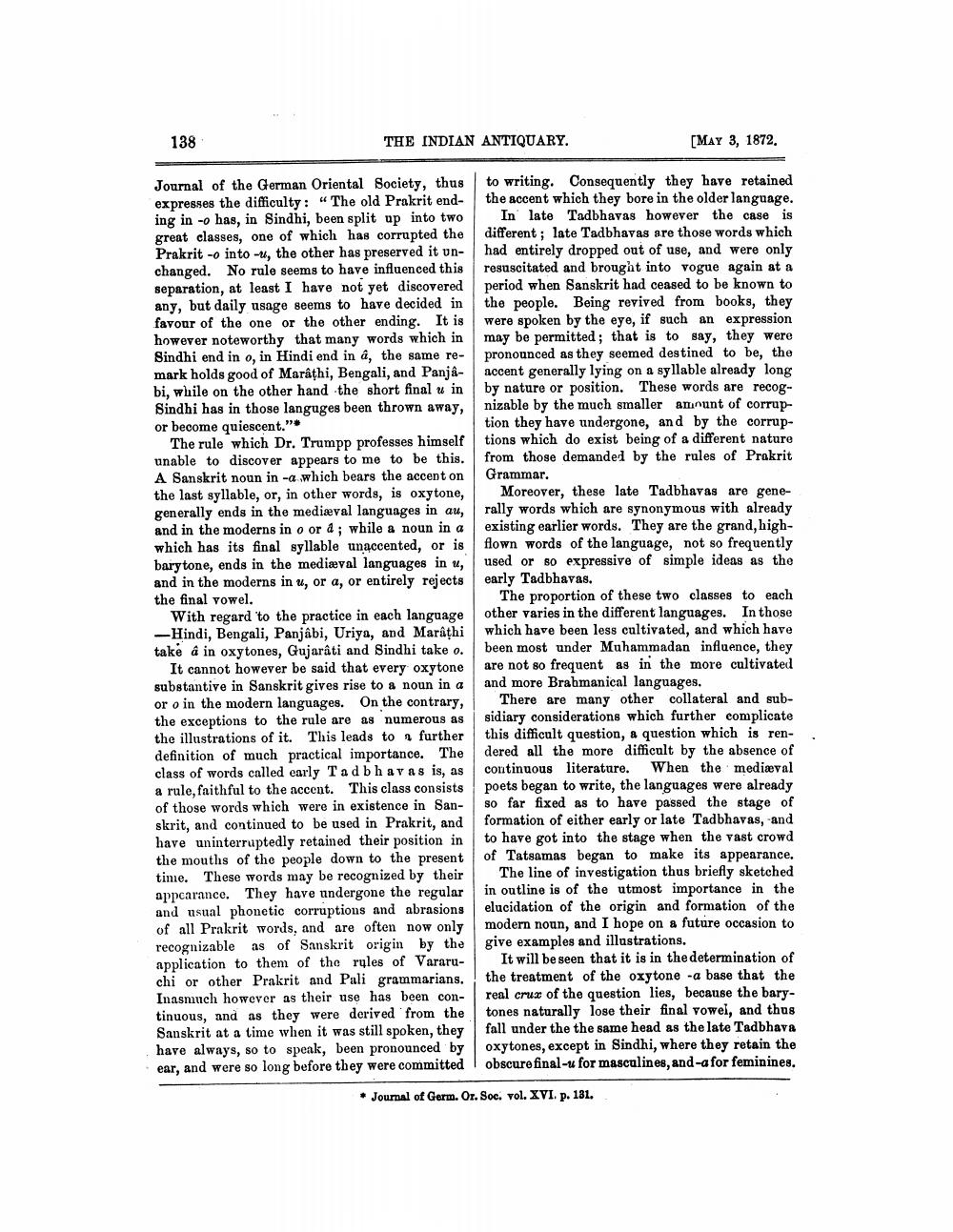________________
138
THE INDIAN ANTIQUARY.
Journal of the German Oriental Society, thus expresses the difficulty: "The old Prakrit ending in -o has, in Sindhi, been split up into two great classes, one of which has corrupted the Prakrit o into -u, the other has preserved it unchanged. No rule seems to have influenced this separation, at least I have not yet discovered any, but daily usage seems to have decided in favour of the one or the other ending. It is however noteworthy that many words which in Sindhi end in o, in Hindi end in â, the same remark holds good of Marathi, Bengali, and Panjâbi, while on the other hand the short final u in Sindhi has in those languges been thrown away, or become quiescent."*
The rule which Dr. Trumpp professes himself unable to discover appears to me to be this. A Sanskrit noun in -a which bears the accent on the last syllable, or, in other words, is oxytone, generally ends in the medieval languages in au, and in the moderns in o or d; while a noun in a which has its final syllable unaccented, or is barytone, ends in the medieval languages in u, and in the moderns in u, or a, or entirely rejects the final vowel.
[MAY 3, 1872.
to writing. Consequently they have retained the accent which they bore in the older language.
In late Tadbhavas however the case is different; late Tadbhavas are those words which had entirely dropped out of use, and were only resuscitated and brought into vogue again at a period when Sanskrit had ceased to be known to the people. Being revived from books, they were spoken by the eye, if such an expression may be permitted; that is to say, they were pronounced as they seemed destined to be, the accent generally lying on a syllable already long by nature or position. These words are recognizable by the much smaller amount of corruption they have undergone, and by the corruptions which do exist being of a different nature from those demanded by the rules of Prakrit Grammar.
With regard to the practice in each language -Hindi, Bengali, Panjabi, Uriya, and Marathi take a in oxytones, Gujarâti and Sindhi take o.
It cannot however be said that every oxytone substantive in Sanskrit gives rise to a noun in a or o in the modern languages. On the contrary, the exceptions to the rule are as numerous as the illustrations of it. This leads to a further definition of much practical importance. The class of words called early Tad bhavas is, as a rule, faithful to the accent. This class consists of those words which were in existence in Sanskrit, and continued to be used in Prakrit, and have uninterruptedly retained their position in the mouths of the people down to the present time. These words may be recognized by their appearance. They have undergone the regular and usual phonetic corruptions and abrasions of all Prakrit words, and are often now only recognizable as of Sanskrit origin by the application to them of the rules of Vararuchi or other Prakrit and Pali grammarians. Inasmuch however as their use has been continuous, and as they were derived from the Sanskrit at a time when it was still spoken, they have always, so to speak, been pronounced by ear, and were so long before they were committed
Moreover, these late Tadbhavas are generally words which are synonymous with already existing earlier words. They are the grand, highflown words of the language, not so frequently used or so expressive of simple ideas as the early Tadbhavas.
The proportion of these two classes to each other varies in the different languages. In those which have been less cultivated, and which have been most under Muhammadan influence, they are not so frequent as in the more cultivated and more Brahmanical languages,
There are many other collateral and subsidiary considerations which further complicate this difficult question, a question which is rendered all the more difficult by the absence of continuous literature. When the mediaval poets began to write, the languages were already so far fixed as to have passed the stage of formation of either early or late Tadbhavas, and to have got into the stage when the vast crowd of Tatsamas began to make its appearance.
The line of investigation thus briefly sketched in outline is of the utmost importance in the elucidation of the origin and formation of the modern noun, and I hope on a future occasion to give examples and illustrations.
It will be seen that it is in the determination of the treatment of the oxytone -a base that the real crux of the question lies, because the barytones naturally lose their final vowel, and thus fall under the the same head as the late Tadbhava oxytones, except in Sindhi, where they retain the obscure final-u for masculines, and -a for feminines.
Journal of Germ. Or. Soc. vol. XVI. p. 131.




